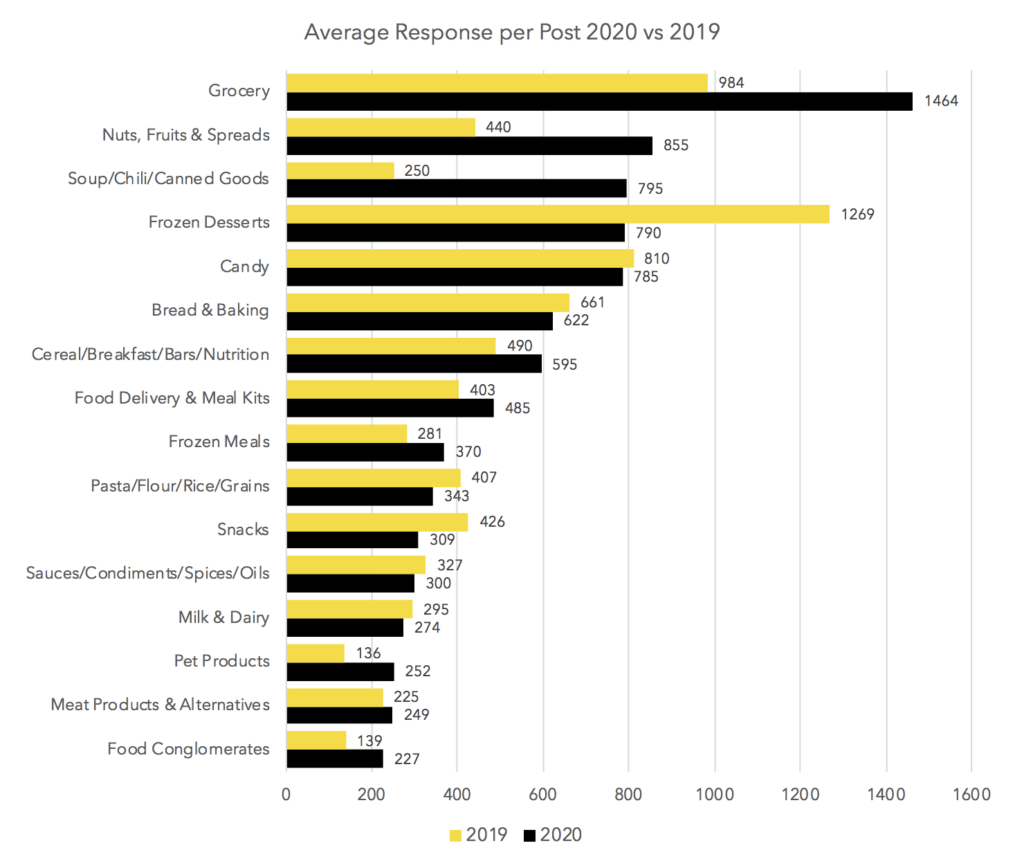- Food Industry Executive
- Posts
- Social Media for Food Brands in the Time of COVID-19
Social Media for Food Brands in the Time of COVID-19

How has COVID-19 changed consumer response to social media posts by food brands? To find out, ListenFirst, a social media analytics platform, measured the volume of reactions, comments, shares, retweets, and likes for new posts on Instagram, Facebook, and Twitter, and compared them to last year. Food Industry Special Report: Social Media in the Time of Coronavirus presents the results, along with recommendations for best social media posting practices at this time.
In general, social media engagement for most food categories has increased from 2019 as CPG foods have become more significant in people’s daily lives. Only the frozen desserts category notably decreased in social engagement year over year. “Given the unique and unfortunate circumstances, this might be the moment when the audience is most receptive to messaging from food brands on social media,” said Tracy David, Chief Marketing Officer at ListenFirst.
Posts with the most increased responses were from soup/chili/canned goods brands. They averaged over 120% more content responses per post, looking at the weeks of March 9 to April 13, 2020 compared to the weeks of March 4 to April 15, 2019. Seeing the second largest rise in engagement were grocery brands, averaging over 103% more responses per post. The following chart shows changes for other food categories.

Before COVID-19, Instagram was easily the leading platform for social media engagement for the food industry. Now, Facebook has gained significance. CPG food brand posts about how they’re helping support essential workers and grocery store posts about store openings have fueled increased responses on Facebook.
When to post on social media
With so many people working from home, food marketers need to reevaluate the best time to post on social media, according to the report.
On Facebook, the best content response rate, by far, for food industry posts is between 6–9am PST. The evening, especially 6–9pm PST, is also an opportunity to generate greater engagement on posts.
On Instagram, during the week of April 6, the highest response rate (0.41%) to posts was between 3–6am PST. However, the food industry released most of its top 1,000 performing Instagram posts from 9am–12pm PST, when the content response rate was only 0.21%. “Posting in the early morning, when there’s less competition from other food brands in people’s feeds, is currently the best time for CPG food brands to post on Instagram,” according to the report.
What to post on social media
What can brands post to generate consumer response on social media?
Do a giveaway. Giveaway posts were the most responded-to posts for brands.
Let consumers know how you are supporting essential workers and food banks. These types of posts get some of the highest social media engagement. “As much as the social audience likes getting free stuff, they also like seeing people in need getting free food,” states the report.
Encourage consumer-generated content. It’s more effective than ever. It brings people closer to a brand and inspires others to get creative with food recipes at home. “People are looking for ways to connect with one another. Loyal customers are also more loyal than ever,” states the report. “Take advantage of this period to offer your fans a sense of togetherness connected by a similar thread, your brand.”
Offer practical advice. With people cooking and eating more at home, they seek practical tips and tricks.
Post recipes. Recipes have always been a good go-to for some brands. But even brands that normally wouldn’t think of posting recipes can benefit from doing so. For example, OREO got 71,426 responses for a recipe for mug cake and 41,942 responses for a recipe for OREO cheesecake bars.
Other posts getting good social media engagement include ones showing how a brand fits with people’s changed lifestyles, nostalgic throwback posts, fun games or other entertaining activities, and messages about immunity and healthy eating.
What’s next? “A messaging strategy around re-opening and managing people’s anxiety should be top of mind of brand marketers as they think about what comes next,” states the report. “While people are eager for life in lockdown to end, many are still expressing anxiety.”